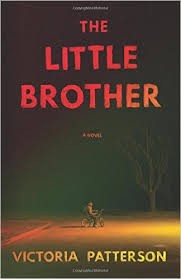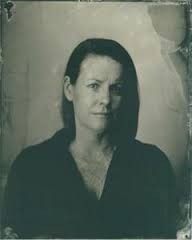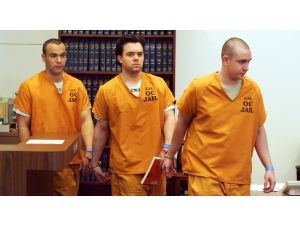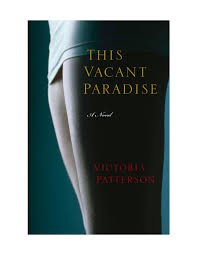
The writer Victoria Patterson's name should by now already be at the top of everybody's unlikely if welcome list of sincere and important and, yes, esteemed Orange County writers of literary fiction. It's actually a pretty strong list, and if you need further convincing, do check out this column's archives, recently celebrating poet Grant Hier and novelist Peggy Hesketh and more. Yet Patterson stands out this week, for all kinds of reasons. Her first two books, a debut literary short story collection (Drift) and a novel (This Vacant Paradise) helpfully advertised their social, existential and political themes (at least to those in the know) about the weird county in which we live, by way of breezy privilege and hollow excess. She was acclaimed as the Edith Wharton of the OC, which is surely just plain fun to say, but it was an accurate if perhaps purposely and purposefully self-constructed comparison, not the least because the writing and the analysis are so strong and brave and, importantly, nobody else encouraged that association, not from Orange County, CA anyway! Then Patterson pivoted, gracefully, to writing a different kind of social critique in The Peerless Four, if with the same vigorous and also stylish class and feminist-historical critiques, this time reimagining the story – or speculating or elaborating on it – of four women Olympic athletes and the singular lady coach whose own story demands revisionism of nearly everything about the period of the story, its quiet prejudices, its loud and clumsy ones, its so-called truths and received wisdom and received stupidity.
]

Now arrives The Little Brother, a book you might say she had to write, a roman a clef, a Young Adult fiction for grown-ups, a small confessional first-person story about a very much bigger one with all kinds of implications, that singularly OC story of the past decade, of lurid political hijinx nicely, instructively paralleling in its mimicry all the adult misbehavior of the previous three novels, and - as they say - then some. Lots. You will by now already have heard that The Little Brother is the story of the infamous Haidl gang-rape case, with its tentacular reach or embrace, into and from the real houses of the housewives and house-husbands of Orange County, and the kids they raise. Along with the county's bankruptcy, it became something horribly, helpfully emblematic of one part of the story of this odd place of concentrated wealth and easeful self-regard if famously blissful lack of self-awareness. The wannabe cop-corrupt businessman (yes, a variety of used car salesman and "self-made millionaire), the criminal sheriff, the white-boy gangster rapists. All all of it (and all of them) played cartoon characters instead of human people, living their unexamined lives if all over-examined by the Spectacle-machine because although it was something nobody would have learned of, seen, perhaps cared about (for good or bad) otherwise, the actual drunken, violent, misogynistic boy-crime itself was, of course, memorialized on tape by, yes, wait for it, the perps themselves.

Patterson's novel version of all of the above (and more) makes for an equally odd book, puzzling if perhaps necessarily so, perhaps two books, actually. Its Awkward-Kid Now Grown-up (sort of) retelling of the whole awful episode is required reading for both the citizen-readers of OC (and beyond) as well as general readers who will further appreciate this talented, provocative, smart and empathetic writer of fiction whose work so depends on what we on the Left used to call an analysis and we on the Lit call perspective. So, again, a dialectic.
The dumb if sensitive kid narrator, writing much later we learn as an adult (again, sort of), shares his origin story early, letting us know intentionally or not that he is still a kind of cipher, a stand-in for so many perspectives and potential versions of the story, or stories here, about stories. Early on, his name, "Even" suggests both revenge as in getting even but also evening things out, bringing balance, redistributing resources as illustrated in his family lore story about sharing with his slightly older brother Gabe, the damaged and doomed stand-in for Gregory Haidl, the real-life son of Don Haidl, tax cheater and pal of the super-macho chief law enforcement official of OC, "America's sheriff" and Bush pal. The real-life (a negotiable term) Haidl is by the way now dead, Carona is out of jail, Greg ("Gabe") is on parole and objecting to being forced to register as a convicted sex offender, of all things.

So, yes, for the young woman fiction writer originally from Corona del Mar who has so elegantly, surgically beautifully, yet empathetically portrayed the earlier and institutional scenes of everyday social crimes, this "true crime" event telling must have been impossible not to see as her own, yet again. But how to tell it? I confess to being at first confused by the sometimes flat voice, the stripped-down, fast-moving and almost journal-like writing, so different from unsparingly sophisticated language of the previous three books. But I reminded myself that good writers famously need good readers, maybe good audiences, maybe bigger audiences and think I got it, with help from another review. As it happens, while an OC local as myself, all too familiar with the infamous case, looked for and easily spotted the fictional stand-ins for Jane Doe, the Haidls, Carona, the OC Weekly investigative journalist himself and more, the novel apparently works - and then some, boy howdy! - for people perhaps unaware in the first place of it putative source material. Hard to figure: the extremely strong recent review of The Little Brother in The New York Times did not even mention the actual case, the reviewer either not knowing or somehow not caring. And absolutely loved the book regardless!
Weird, but that's in part what got me thinking more about (figuring, puzzling about) Patterson's ambitions, my two-books-in-one theory and the choices made here, again, by way of narrator, perspective, the predictably gorgeous writing set against a tone and affect and almost Oprah-like confessional-therapeutic gestalt which finally defines, I argue here, not only the novel's plot but the take-away about our estrangement from telling our own stories when faced with their cruel absurdity. And how we respond to the cultural insistence that we not be real people at all, that we not acknowledge the psychic suffering or celebration of ubiquitous consciousness-scarring by endless fragmented images, the resultant self-exile of adults from Real Life, the annoying omnipresence of a device-driven universe ("electronic hallucinations," Derrick Jensen calls them) and the lack of consequences (mostly) for all of the above.
So, how to tell a novel told by a character who struggles to appreciate, understand the enormity of his victimization and others', the complicity of neighborhood and family? How to trust a necessarily, artfully contrived fictional young person character meant to represent an actually, already sociologically contrived "real" young person from an all-too-real unreal place? How to chart the intellectual, moral development of character so lacking in, yes, artifice? Patterson must have felt she, of all people, had to tell that meta-story, with that particular challenge. As regards the project and her eponymous Even, clever readers by now be thinking of Clay (yes, "clay") in Less Than Zero, or even Maria (yes, "Mar-eye-ah") in Didion's Play It As It Lays, in which a removed, alienated, damaged voice so shaped by circumstance, yet who so shapes our understanding of it, tells his or her particular version of the story. These two ur-California novels include, as it happens, darkness in sunlight, bad behavior, cruelty and taking pictures of it all (Maria is an actress, natch). So that perhaps good writers need good, appropriate, unattractive narrators (or bad, as in unreliable, innocent, impossibly immature) whose own rhetorical feints, faux insights or presumed omniscience say as much about it all as do the events and characterizations which propel the story.
All of which is to say that when Even, who faces and makes some ostensibly difficult moral, ethical, political choices about his allegiances to family and tribe of Newport Beach, CA, they arrive with both the authorial direction of Patterson and the voice of a disturbingly try-on substitute persona, a struggling for authenticity from a not very sophisticated young man, as in the voice of a Young Adult protagonist being interviewed by Dr. Phil and otherwise adopting the idiom of a certain kind of worldview with not much knowledge of the world and not much view beyond, yes, what he's seen and what, indeed, he has been given by way of clues to his redemption via his creator, one V. Patterson. So that although Gabe occasionally indicates startingly unlikely touchstones (the neo-realist short story writer Raymond Carver, for instance - how does he know Carver?) his otherwise ordinary daily insights are grounded in Demerol use and Jay Z and shopping at Target. That's why this book strikes me as a YA novel, if a subversive one while also a literary true crime story. A two-fer. While previous characters offered a more obviously, elaborately developed awareness about persons, places and things, our young Gabe seems eager to find his difficult way just to get out of this nightmare story. Unlike the earlier protagonists, composite or autobiographical teens and adults, who seem to require and get a more helpful kind of resolution, a viable and possibility-rich future or adulthood post-victimization, it feels to this reader that this one has only just survived, if surviving in the end as something much closer to, yes, a real-live, real and alive person. Or the beginnings of one, struggling to be, to behave outside of the cartoon cast of caricature and the limits of the idiom it depends on.
Perhaps that's actually the very best he can achieve, given how unprepared he is, how brave he has tried to be, how predetermined his circumstances. It's as if Patterson is trying to arm him with some kind of intellectual self-defense, poetry, glimpses of autonomy, and the possibility of imagination as against the empty tell-all cultural narrative option which so overwhelms his other story, ours, as in the description of this scene at a cemetery:
A hazy, gorgeous afternoon, slight breeze, lean clouds swimming the sky, matching gravestones down the hill, row after row, reminding me of the tract homes in Cucamonga.
That's our author, yes, teaching her invention or reinvention to be genuine, multi-dimensional. In The Little Brother, a book which should be a popular read here, Patterson sets aside a lot of the line-level satisfactions of her previous work to get to the immediate and urgent business of redeeming Gabe, liberating him, perhaps in order to help Gabe himself - and people like him - to see the landscape for what it is, and perhaps to see beyond the overwhelming construction of unreality, and to live elsewhere.
Victoria Patterson, The Little Brother, Counterpoint Press, 320 pgs., $25.
Andrew Tonkovich edits the West Coast literary journal Santa Monica Review and hosts the weekly books show Bibliocracy Radio, Wednesdays nights at 8 PM on listener-supported non-corporate Pacifica Radio KPFK 90.7 FM in Southern California.

